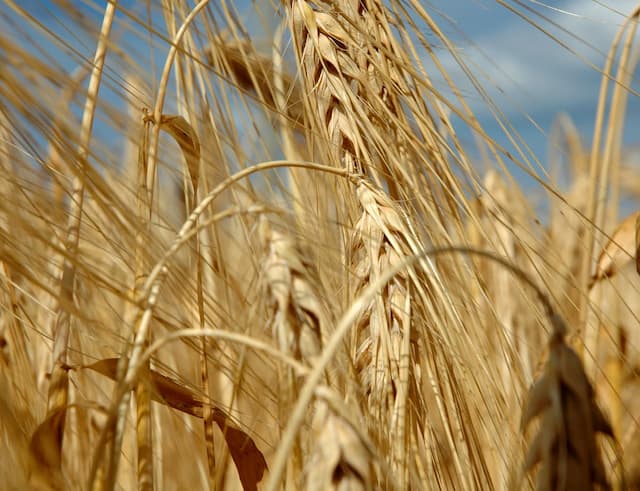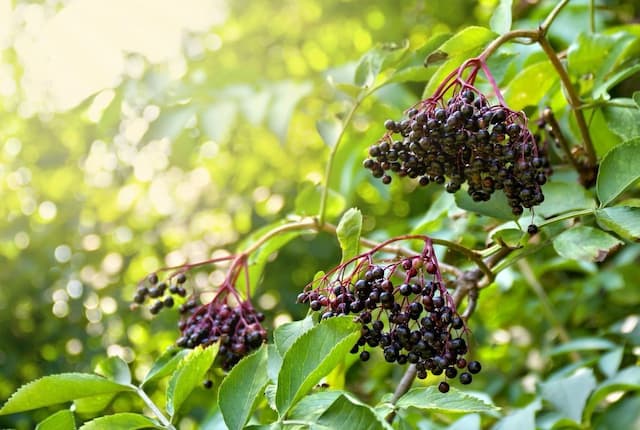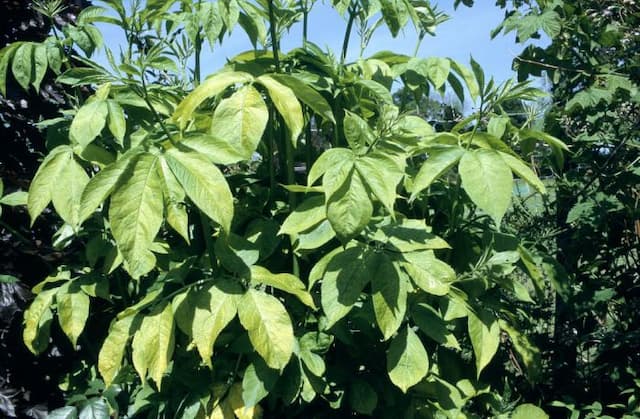Laurustinus Viburnum tinus 'Lucidum'

ABOUT
The Viburnum tinus 'Lucidum', commonly known as the Laurustinus, is a broadleaf evergreen shrub that boasts a dense, rounded habit. Its deep green, glossy leaves offer a lush backdrop throughout all seasons. Each leaf has an oval shape with a slightly toothed margin, typically coming to a prominent point. The Laurustinus is known for its profuse flowering throughout late winter into early spring. The blossoms emerge in striking, flat-topped clusters called cymes at the tips of the branches. These flowers are small, with a delicate, five-petaled form; they are typically a shade of pink in bud, opening up into a clean white. Following the flowering season, Laurustinus can also produce a display of berries. The berry fruits first appear as a blue-black and may attract birds and wildlife to the garden. The overall texture of the shrub is somewhat coarse due to the bold leaves and flower clusters, yet this adds to its visual interest and structural form in landscaping. Laurustinus can serve as a backdrop in mixed borders or as part of a hedging scheme, delivering year-round attractiveness with its evergreen leaves, appealing flowers, and occasional berries. Its ability to maintain a neat appearance with minimal pruning also makes it a low-maintenance option for gardeners.
About this plant
 Names
NamesFamily
Adoxaceae
Synonyms
Laurustinus, Laurestine
Common names
Viburnum tinus 'Lucidum'.
 Toxicity
ToxicityTo humans
Laurustinus, the common name for Viburnum tinus 'Lucidum', is considered to have a low level of toxicity to humans. If ingested, parts of the plant, especially the berries, can potentially cause symptoms such as vomiting, diarrhea, and abdominal pain. In general, consuming laurustinus isn't expected to cause serious poisoning, but it can result in discomfort and gastrointestinal upset.
To pets
Laurustinus is also considered mildly toxic to pets, including dogs and cats. Ingesting parts of the plant can lead to symptoms like vomiting, diarrhea, and sometimes drooling in pets. While severe toxicity is uncommon, it is advisable to prevent pets from consuming laurustinus to avoid gastrointestinal upset.
 Characteristics
CharacteristicsLife cycle
Perennials
Foliage type
Evergreen
Color of leaves
Dark green
Flower color
White
Height
6-12 feet (1.8-3.6 meters)
Spread
6-12 feet (1.8-3.6 meters)
Plant type
Shrub
Hardiness zones
7
Native area
Mediterranean
Benefits
 General Benefits
General Benefits- Year-round interest: Viburnum tinus 'Lucidum' provides visual interest throughout all seasons with its evergreen leaves, spring flowers, and often colorful berries.
- Aesthetic appeal: The plant features clusters of white flowers that are appealing in landscape design, often enhancing garden aesthetics.
- Wildlife attraction: The flowers attract pollinators like bees, while the berries can attract birds, adding biodiversity to the garden.
- Privacy screen: With its dense growth habit, it can be used as a hedge or screen, offering privacy to outdoor spaces.
- Low maintenance: This particular variety is known for being low-maintenance, requiring minimal pruning and care once established.
- Durability: It is hardy in a range of conditions, including cold temperatures, and can tolerate a variety of soils.
- Versatility in landscaping: The plant can be used in various ways in a garden, including as a specimen plant, in borders, or as part of a foundation planting scheme.
- Shade tolerance: Viburnum tinus 'Lucidum' can grow in partially shaded areas, making it suitable for understory planting and shaded gardens.
 Medical Properties
Medical PropertiesThis plant is not used for medical purposes.
 Air-purifying Qualities
Air-purifying QualitiesThis plant is not specifically known for air purifying qualities.
 Other Uses
Other Uses- Privacy Screening: Viburnum tinus 'Lucidum', commonly known as Laurustinus, can be used to create dense hedges for privacy screens due to its evergreen nature and robust growth habit.
- Topiary or Ornamental Shapes: Laurustinus can be pruned into various shapes and is often used as topiary in formal gardens.
- Natural Bird Habitat: Its dense foliage provides shelter and its berries offer food for a variety of bird species, making it an ideal choice for bird enthusiasts to plant in their gardens.
- Coastal Gardening: Due to its tolerance to salt spray, Laurustinus is a suitable plant for coastal areas and can be used in seaside garden designs.
- Sound Barrier: The dense growth of Laurustinus hedges can help dampen noise, making it an effective natural sound barrier for properties near busy roads.
- Erosion Control: Laurustinus can be used on slopes or in areas prone to erosion to help stabilize the soil with its root system.
- Dried Flower Arrangements: The flowers of Laurustinus, when dried, can retain their shape and color, making them a popular choice for use in long-lasting floral displays.
- Windbreaks: Planting Laurustinus shrubs in rows can act as windbreaks to protect gardens and outdoor living spaces from harsh winds.
- Landscape Mass Planting: Laurustinus is often used in mass planting schemes in public parks and large gardens for its aesthetic appeal and low maintenance needs.
- Photography Backdrops: With its lush greenery and attractive blooms, Laurustinus can serve as a natural backdrop for outdoor photography and garden weddings.
Interesting Facts
 Feng Shui
Feng ShuiThe Laurustinus is not used in Feng Shui practice.
 Zodiac Sign Compitability
Zodiac Sign CompitabilityThe Laurustinus is not used in astrology practice.
 Plant Symbolism
Plant Symbolism- Renewal: Viburnum tinus 'Lucidum', commonly known as Laurustinus, typically blooms in late winter to early spring, symbolizing the triumph of life and renewal over the dormant winter period.
- Eternal Life: The evergreen nature of Laurustinus represents continuity and immortality, suggesting an enduring or eternal life.
- Protection: Historically, some species of Viburnum were believed to offer protection. Laurustinus can be symbolic of safeguarding oneself or a space against negative influences.
- Boundaries: With its dense growth habit, Laurustinus can be seen as a symbol for setting boundaries—both physically in gardens and metaphorically in personal life.
- Beauty: Laurustinus blossoms are often appreciated for their aesthetic appeal, symbolizing appreciation for beauty and refinement in the plant world.
 Water
WaterLaurustinus should be watered thoroughly, ensuring the soil is moist but not waterlogged. For young plants, water once or twice a week, allowing the soil to dry out slightly between watering sessions. Adult plants are more drought-tolerant and usually require less frequent watering, especially if they are planted in the ground and have established a strong root system. During dry spells or hot weather, increase watering to once a week, providing about 1 to 1.5 gallons of water per plant, depending on the size.
 Light
LightLaurustinus thrives best in full sun to partial shade. Place the plant in a location where it can receive at least four to six hours of direct sunlight per day. It can tolerate some shade, particularly in hotter climates, but too much shade may reduce flowering and can lead to leggy growth.
 Temperature
TemperatureLaurustinus prefers temperate climates and is generally comfortable in temperatures ranging from 20°F to 80°F. It can survive short periods of colder temperatures down to 10°F, but prolonged exposure to extreme cold can damage the plant. The ideal temperature range for this shrub is between 50°F and 70°F to promote healthy growth and flowering.
 Pruning
PruningPrune Laurustinus in late winter or early spring to maintain its shape and remove any dead or diseased wood. Light pruning can also encourage denser growth and a more prolific bloom. It is typically sufficient to prune once a year, just as the plant finishes blooming to avoid cutting off next year's buds.
 Cleaning
CleaningNot needed
 Soil
SoilLaurel bushes, commonly known as Viburnum tinus, thrive in well-draining soil with a pH of 5.5 to 6.5. A mix of two parts garden soil, one part peat moss, and one part perlite or sand is ideal. This ensures adequate drainage and a slight acidity that this shrub prefers.
 Repotting
RepottingLaurel bushes do not require frequent repotting; it is typically done every three to five years. When the plant outgrows its current container, choose a new pot that is slightly larger and repot in the spring.
 Humidity & Misting
Humidity & MistingLaurel bushes are adaptable to different humidity levels but prefer moderate to high humidity. They tolerate outdoor humidity naturally and do not have specific indoor humidity requirements.
 Suitable locations
Suitable locationsIndoor
Place Laurel in bright, indirect light and keep it in cool temperatures.
Outdoor
Plant Laurel in partial shade to full sun and protect from strong winds.
Hardiness zone
7-11 USDA
 Life cycle
Life cycleViburnum tinus, commonly known as Laurustinus 'Lucidum', begins its life cycle when seeds are dispersed and germinate in suitable conditions with well-drained soil and partial to full sun. The seedlings establish roots and develop into juvenile plants with characteristic glossy, evergreen leaves and a dense, shrub-like form. As the plant matures, it enters a phase of vegetative growth, expanding in height and spread, and it may begin to flower during the winter to spring months, displaying clusters of small white or light pink blossoms. Following pollination, typically by insects, the flowers develop into small, dark blue-purple berries (drupes) by late summer or early autumn. These fruits are attractive to birds, which can then disperse the seeds, perpetuating the life cycle. Over time, Laurustinus 'Lucidum' can reach up to 10-15 feet in height and width, with some pruning required to maintain shape, promote air circulation, and remove any dead or diseased wood.
 Propogation
PropogationPropogation time
Late Summer to Autumn
The most popular method of propagating Viburnum tinus 'Lucidum', commonly known as Laurustinus, is through semi-ripe stem cuttings. This type of propagation is typically done in late summer. To propagate by this method, a gardener would select a healthy, semi-ripe stem that has begun to harden but is not yet woody. They would then cut a length of 4 to 6 inches (approximately 10 to 15 centimeters), making sure that each cutting has several leaves. The lower leaves are removed, and the cut end is often dipped in a rooting hormone to promote root development. The cutting is then inserted into a pot filled with a well-draining potting mix. It's important to keep the soil consistently moist and to provide the cuttings with a warm environment and indirect light until they root, after which they can be transplanted.



![Elder [Black Tower]](/_next/image?url=https%3A%2F%2Fplants-admin.emdemapps.com%2Fimages%2Fplants%2F%2Fimages%2F604b5cad99578.png&w=640&q=75)





